COVID Crisis and Tourism Sustainability: An Insightful Bibliometric Analysis
Abstract
1. Introduction
2. Research Methodology
2.1. Data Collection and Search Strategy
2.2. Data Analysis and Network Visualization
3. Results
3.1. Data Summary
3.2. Authors’ Productivity and Lotka’s
3.3. Sources’ Productivity and Bradford’s Law
3.4. Keywords’ Analysis and Zipf’s Law
3.5. Citation Analysis
3.6. Countries and Institutions
3.7. Conceptual Structure of Knowledge
3.8. Intellectual Structure of Knowledge
3.9. Social Structure of Knowledge
4. Discussion
5. Conclusions
Author Contributions
Funding
Data Availability Statement
Conflicts of Interest
References
- Chaudhary, A. Impact and Survival Strategy for Hospitality Industry after COVID-19. Int. J. Innov. Sci. Res. Technol. 2020, 5, 489–492. Available online: https://ijisrt.com/assets/upload/files/IJISRT20NOV427.pdf (accessed on 18 August 2022).
- Mestanza, J.G.; Bakhat, R. A fuzzy ahp-mairca model for overtourism assessment: The case of Malaga province. Sustainability 2021, 13, 6394. [Google Scholar] [CrossRef]
- Palacios-Florencio, B.; Santos-Roldán, L.; Berbel-Pineda, J.M.; Castillo-Canalejo, A.M. Sustainable Tourism as a Driving force of the Tourism Industry in a Post-COVID-19 Scenario. Soc. Indic. Res. 2021, 158, 991–1011. [Google Scholar] [CrossRef] [PubMed]
- Tsai, M.-C. Developing a sustainability strategy for Taiwan’s tourism industry after the COVID-19 pandemic. PLoS ONE 2021, 16, e0248319. [Google Scholar] [CrossRef]
- Goel, P.; Garg, A.; Walia, N.; Kaur, R.; Jain, M.; Singh, S. Contagious diseases and tourism: A systematic review based on bibliometric and content analysis methods. Qual. Quant. 2021, 56, 3085–3110. [Google Scholar] [CrossRef]
- Castanho, R.A.; Couto, G.; Sousa, Á.; Pimentel, P.; Batista, M.D.G. Assessing the impacts of the COVID-19 pandemic over the azores region’s touristic companies. Sustainability 2021, 13, 9647. [Google Scholar] [CrossRef]
- Lapointe, D. Reconnecting tourism after COVID-19: The paradox of alterity in tourism areas. Tour. Geogr. 2020, 22, 633–638. [Google Scholar] [CrossRef]
- Lebrun, A.-M.; Su, C.-J.; Bouchet, P. A more sustainable management of domestic tourists in protected natural parks: A new trend in sport tourism after the COVID-19 pandemic? Sustainability 2021, 13, 7750. [Google Scholar] [CrossRef]
- Moreno-Luna, L.; Robina-Ramírez, R.; Sánchez, M.S.-O.; Castro-Serrano, J. Tourism and sustainability in times of COVID-19: The case of Spain. Int. J. Environ. Res. Public Health 2021, 18, 1859. [Google Scholar] [CrossRef]
- Higgins-Desbiolles, F. The “war over tourism”: Challenges to sustainable tourism in the tourism academy after COVID-19. J. Sustain. Tour. 2020, 29, 551–569. [Google Scholar] [CrossRef]
- Eichelberger, S.; Heigl, M.; Peters, M.; Pikkemaat, B. Exploring the role of tourists: Responsible behavior triggered by the COVID-19 pandemic. Sustainability 2021, 13, 5774. [Google Scholar] [CrossRef]
- Liu, H.; Wu, P.; Li, G. Do crises affect the sustainability of the economic effects of tourism? A case study of Hong Kong. J. Sustain. Tour. 2021. [Google Scholar] [CrossRef]
- Higgins-Desbiolles, F. Socialising tourism for social and ecological justice after COVID-19. Tour. Geogr. 2020, 22, 610–623. [Google Scholar] [CrossRef]
- Vărzaru, A.A.; Bocean, C.G.; Cazacu, M. Rethinking tourism industry in pandemic COVID-19 period. Sustainability 2021, 13, 6956. [Google Scholar] [CrossRef]
- Hoarau, J.-F. Is international tourism responsible for the outbreak of the COVID-19 pandemic? A cross-country analysis with a special focus on small islands. Rev. World Econ. 2021, 158, 493–528. [Google Scholar] [CrossRef]
- Sigala, M. Tourism and COVID-19: Impacts and implications for advancing and resetting industry and research. J. Bus. Res. 2020, 117, 312–321. [Google Scholar] [CrossRef]
- Chang, C.L.; McAleer, M.; Ramos, V. A charter for sustainable tourism after COVID-19. Sustainability 2020, 12, 3671. [Google Scholar] [CrossRef]
- Marujo, N.; Borges, M.D.R.; Serra, J.; Coelho, R. Strategies for creative tourism activities in pandemic contexts: The case of the ‘saídas de mestre’ project. Sustainability 2021, 13, 10654. [Google Scholar] [CrossRef]
- Persson-Fischer, U.; Liu, S. The impact of a global crisis on areas and topics of tourism research. Sustainability 2021, 13, 906. [Google Scholar] [CrossRef]
- Fletcher, R.; Blanco-Romero, A.; Blázquez-Salom, M.; Cañada, E.; Murray Mas, I.; Sekulova, F. Pathways to post-capitalist tourism. Tour. Geogr. 2021. [Google Scholar] [CrossRef]
- Mach, L.J. Surf tourism in uncertain times: Resident perspectives on the sustainability implications of COVID-19. Societies 2021, 11, 75. [Google Scholar] [CrossRef]
- Suhail, K.S.J.; Naamo, G.S.; AlJashaam, A.A.G. The effect of strategic foresight on tourism marketing after COVID-19. Afr. J. Hosp. Tour. Leis. 2019, 8, 1–11. Available online: https://www.ajhtl.com/uploads/7/1/6/3/7163688/article_41_8_1__2019_iraq.pdf (accessed on 18 August 2022).
- Galvani, A.; Lew, A.A.; Perez, M.S. COVID-19 is expanding global consciousness and the sustainability of travel and tourism. Tour. Geogr. 2020, 22, 567–576. [Google Scholar] [CrossRef]
- Pritchard, A. Statistical Bibliography or Bibliometrics? J. Doc. 1969, 25, 348–349. Available online: https://www.researchgate.net/publication/236031787_Statistical_Bibliography_or_Bibliometrics (accessed on 18 August 2022).
- Donthu, N.; Kumar, S.; Mukherjee, D.; Pandey, N.; Lim, W.M. How to conduct a bibliometric analysis: An overview and guidelines. J. Bus. Res. 2021, 133, 285–296. [Google Scholar] [CrossRef]
- Ramos-Rodríguez, A.-R.; Ruíz-Navarro, J. Changes in the Intellectual Structure of Strategic Management Research: A Bibliometric Study of the “Strategic Management Journal”, 1980–2000. Strateg. Manag. J. 2004, 25, 981–1004. [Google Scholar] [CrossRef]
- Kent Baker, H.; Pandey, N.; Kumar, S.; Haldar, A. A bibliometric analysis of board diversity: Current status, development, and future research directions. J. Bus. Res. 2020, 108, 232–246. [Google Scholar] [CrossRef]
- Tunger, D.; Eulerich, M. Bibliometric analysis of corporate governance research in German-speaking countries: Applying bibliometrics to business research using a custom-made database. Scientometrics 2018, 117, 2041–2059. [Google Scholar] [CrossRef]
- Wijesinghe, S.N.R.; Mura, P.; Bouchon, F. Tourism knowledge and neocolonialism—A systematic critical review of the literature. Curr. Issues Tour. 2019, 22, 1263–1279. [Google Scholar] [CrossRef]
- Araya-Castillo, L.; Hernández-Perlines, F.; Millán-Toledo, C.; Ibarra Cisneros, M.A. Bibliometric analysis of studies on family firms. Econ. Res.-Ekon. Istraživanja 2021, 35, 4778–4800. [Google Scholar] [CrossRef]
- Joshi, A. Comparison between Scopus & ISI Web of Science. J. Glob. Values 2017, 7, e2454-8391. Available online: https://www.researchgate.net/publication/318258303_COMPARISON_BETWEEN_SCOPUS_ISI_WEB_OF_SCIENCE (accessed on 18 August 2022).
- Barki, H.; Rivard, S.; Talbot, J. A Keyword Classification Scheme for IS Research Literature: An Update. MIS Q. 1993, 17, 209–226. [Google Scholar] [CrossRef]
- Palácios, H.; de Almeida, M.H.; Sousa, M.J. A bibliometric analysis of trust in the field of hospitality and tourism. Int. J. Hosp. Manag. 2021, 95, 102944. [Google Scholar] [CrossRef]
- Van Eck, N.J.; Waltman, L. Software survey: VOSviewer, a computer program for bibliometric mapping. Scientometrics 2010, 84, 523–538. [Google Scholar] [CrossRef]
- Waltman, L.; van Eck, N.J.; Noyons, E.C.M. A unified approach to mapping and clustering of bibliometric networks. J. Informetr. 2010, 4, 629–635. [Google Scholar] [CrossRef]
- Ghosh, P.; Ghosh, R.; Chakraborty, B. COVID-19 in India: Statewise Analysis and Prediction. JMIR Public Health Surveill. 2020, 6, e20341. [Google Scholar] [CrossRef]
- Koseoglu, M.A. Growth and structure of authorship and co-authorship network in the strategic management realm: Evidence from the Strategic Management Journal. BRQ Bus. Res. Q. 2016, 19, 153–170. [Google Scholar] [CrossRef]
- Ahmi, A.; Elbardan, H.; Ali, R.H.R.M. Bibliometric Analysis of Published Literature on Industry 4.0. In Proceedings of the 2019 International Conference on Electronics, Information, and Communication (ICEIC), Auckland, New Zealand, 22–25 January 2019; pp. 1–6. [Google Scholar] [CrossRef]
- Elango, B.; Rajendran, P. Authorship trends and collaboration pattern in the marine sciences literature: A scientometric study. Int. J. Inf. Dissem. Technol. 2012, 2, 166–169. Available online: http://www.cindoc.csic.es/cybermetrics/articles/v4i1p4.html (accessed on 18 August 2022).
- Lotka, A.J. The frequency distribution of scientific distribution. J. Wash. Acad. Sci. 1926, 16, 317–323. Available online: https://www.jstor.org/stable/24529203 (accessed on 18 August 2022).
- Devi, B.M. Lokta’s Law Revisited in Toxicology Literature. Library Philosophy and Practice, 0_1. 2013. Available online: https://www.proquest.com/openview/a68559a835d0bffea7ff102ac7bfef37/1?pq-origsite=gscholar&cbl=54903 (accessed on 18 August 2022).
- Gupta, D.K. Lotka’s law and productivity patterns of entomological research in Nigeria for the period, 1900–1973. Scientometrics 1987, 12, 33–46. [Google Scholar] [CrossRef]
- Cheer, J.M. Human flourishing, tourism transformation and COVID-19: A conceptual touchstone. Tour. Geogr. 2020, 22, 514–524. [Google Scholar] [CrossRef]
- Scheyvens, R.; Cheer, J.M. Tourism, the SDGs and partnerships. J. Sustain. Tour. 2021, 30, 2271–2281. [Google Scholar] [CrossRef]
- Sin, H.L.; Mostafanezhad, M.; Cheer, J.M. Tourism geographies in the ‘Asian Century’. Tour. Geogr. 2021, 23, 649–658. [Google Scholar] [CrossRef]
- Ting, H.; Jean, L.X.; Meng, L.C.; Cheah, J.-H.; Cheer, J.M. Editorial—Responsible tourism: A call to action for turbulent times. Asian J. Bus. Res. 2020, 10, ix–xxi. [Google Scholar] [CrossRef]
- McKercher, B. A citation analysis of tourism scholars. Tour. Manag. 2008, 29, 1226–1232. [Google Scholar] [CrossRef]
- Bradford, S.C. Sources of information on specific subjects. Engineering 1934, 137, 85–86. Available online: http://ci.nii.ac.jp/naid/10016754267/en/ (accessed on 18 August 2022).
- Nash-Stewart, C.E.; Kruesi, L.M.; del Mar, C.B. Does Bradford’s Law of Scattering predict the size of the literature in Cochrane Reviews? J. Med. Libr. Assoc. JMLA 2012, 100, 135–138. [Google Scholar] [CrossRef]
- Fairthorne, R.A. Empirical hyperbolic distributions (Bradford-Zipf-Mandelbrot) for bibliometric description and prediction. J. Doc. 2005, 61, 171–193. [Google Scholar] [CrossRef]
- Mingers, J.; Macri, F.; Petrovici, D. Using the h-index to measure the quality of journals in the field of business and management. Inf. Processing Manag. 2012, 48, 234–241. [Google Scholar] [CrossRef]
- Zhang, J.; Yu, Q.; Zheng, F.; Long, C.; Lu, Z.; Duan, Z. Comparing keywords plus of WOS and author keywords: A case study of patient adherence research. J. Assoc. Inf. Sci. Technol. 2015, 67, 967–972. [Google Scholar] [CrossRef]
- Gil-Gonzalez, E.; Pérez-Maqueda, L.; Sánchez-Jiménez, P.; Perejon, A. Flash Sintering Research Perspective: A Bibliometric Analysis. Materials 2022, 15, 416. [Google Scholar] [CrossRef]
- Zipf, G.K. Human Behavior and The Principle of Least Effort: An Introduction to Human Ecology; Addison-Wesley Press: Boston, MA, USA, 1949. [Google Scholar] [CrossRef]
- Piantadosi, S.T. Zipf’s word frequency law in natural language: A critical review and future directions. Psychon. Bull. Rev. 2014, 21, 1112–1130. [Google Scholar] [CrossRef]
- Wyllys, R.E. Empirical and Theoretical Bases of Zipf’s Law. 1981. Available online: https://citeseerx.ist.psu.edu/viewdoc/download?doi=10.1.1.562.5217&rep=rep1&type=pdf (accessed on 18 August 2022).
- Halling, D. Guide to Citation Analysis. Available online: https://tamu.libguides.com/c.php?g=565010 (accessed on 12 October 2021).
- Mulet-Forteza, C.; Martorell-Cunill, O.; Merigó, J.M.; Genovart-Balaguer, J.; Mauleon-Mendez, E. Twenty five years of the Journal of Travel & Tourism Marketing: A bibliometric ranking. J. Travel Tour. Mark. 2018, 35, 1201–1221. [Google Scholar] [CrossRef]
- Hall, C.M.; Scott, D.; Gössling, S. Pandemics, transformations and tourism: Be careful what you wish for. Tour. Geogr. 2020, 22, 577–598. [Google Scholar] [CrossRef]
- Niewiadomski, P. COVID-19: From temporary de-globalisation to a re-discovery of tourism? Tour. Geogr. 2020, 22, 651–656. [Google Scholar] [CrossRef]
- Romagosa, F. The COVID-19 crisis: Opportunities for sustainable and proximity tourism. Tour. Geogr. 2020, 22, 690–694. [Google Scholar] [CrossRef]
- Ioannides, D.; Gyimóthy, S. The COVID-19 crisis as an opportunity for escaping the unsustainable global tourism path. Tour. Geogr. 2020, 22, 624–632. [Google Scholar] [CrossRef]
- Choi, T.-M. Innovative “Bring-Service-Near-Your-Home” operations under Corona-Virus (COVID-19/SARS-CoV-2) outbreak: Can logistics become the Messiah? Transp. Res. Part E Logist. Transp. Rev. 2020, 140, 101961. [Google Scholar] [CrossRef]
- Ibn-Mohammed, T.; Mustapha, K.B.; Godsell, J.; Adamu, Z.; Babatunde, K.A.; Akintade, D.D.; Acquaye, A.; Fujii, H.; Ndiaye, M.M.; Yamoah, F.A.; et al. A critical review of the impacts of COVID-19 on the global economy and ecosystems and opportunities for circular economy strategies. Resour. Conserv. Recycl. 2021, 164, 105169. [Google Scholar] [CrossRef]
- Naidoo, R.; Fisher, B. Reset Sustainable Development Goals for a pandemic world. Nature 2020, 583, 198–201. [Google Scholar] [CrossRef]
- Shamshiripour, A.; Rahimi, E.; Shabanpour, R.; Mohammadian, A.K. How is COVID-19 reshaping activity-travel behavior? Evidence from a comprehensive survey in Chicago. Transp. Res. Interdiscip. Perspect. 2020, 7, 100216. [Google Scholar] [CrossRef]
- Škare, M.; Soriano, D.R.; Porada-Rochoń, M. Impact of COVID-19 on the travel and tourism industry. Technol. Forecast. Soc. Chang. 2021, 163, 120469. [Google Scholar] [CrossRef]
- Rume, T.; Islam, S.M.D.-U. Environmental effects of COVID-19 pandemic and potential strategies of sustainability. Heliyon 2020, 6, e04965. [Google Scholar] [CrossRef]
- Aria, M.; Cuccurullo, C. bibliometrix: An R-tool for comprehensive science mapping analysis. J. Informetr. 2017, 11, 959–975. [Google Scholar] [CrossRef]
- Sharma, P.; Singh, R.; Tamang, M.; Singh, A.K.; Singh, A.K. Journal of teaching in travel &tourism: A bibliometric analysis. J. Teach. Travel Tour. 2021, 21, 155–176. [Google Scholar] [CrossRef]
- Boyack, K.W.; Klavans, R. Co-citation analysis, bibliographic coupling, and direct citation: Which citation approach represents the research front most accurately? J. Am. Soc. Inf. Sci. Technol. 2010, 61, 2389–2404. [Google Scholar] [CrossRef]
- Di Franco, G. Multiple correspondence analysis: One only or several techniques? Qual. Quant. 2016, 50, 1299–1315. [Google Scholar] [CrossRef]
- Filimonau, V.; Archer, D.; Bellamy, L.; Smith, N.; Wintrip, R. The carbon footprint of a UK University during the COVID-19 lockdown. Sci. Total Environ. 2021, 756, 143964. [Google Scholar] [CrossRef] [PubMed]
- O’Connor, P.; Assaker, G. COVID-19′s effects on future pro-environmental traveler behavior: An empirical examination using norm activation, economic sacrifices, and risk perception theories. J. Sustain. Tour. 2021, 30, 89–107. [Google Scholar] [CrossRef]
- Patterson Edward, J.K.; Jayanthi, M.; Malleshappa, H.; Immaculate Jeyasanta, K.; Laju, R.L.; Patterson, J.; Diraviya Raj, K.; Mathews, G.; Marimuthu, A.S.; Grimsditch, G. COVID-19 lockdown improved the health of coastal environment and enhanced the population of reef-fish. Mar. Pollut. Bull. 2021, 165, 112124. [Google Scholar] [CrossRef] [PubMed]
- Bishnoi, M.M.; Suraj, S. Sustainability of public transportation during the pandemic: A descriptive study. J. Green Eng. 2020, 10, 9472–9491. Available online: https://www.scopus.com/inward/record.uri?eid=2-s2.0-85096592832&partnerID=40&md5=6ccc6182c51a23b0d113189881c7c2b6 (accessed on 18 August 2022).
- Ceder, A.A. Urban mobility and public transport: Future perspectives and review. Int. J. Urban Sci. 2021, 25, 455–479. [Google Scholar] [CrossRef]
- Maltese, I.; Gatta, V.; Marcucci, E. Active Travel in Sustainable Urban Mobility Plans. An Italian overview. Res. Transp. Bus. Manag. 2021, 40, 100621. [Google Scholar] [CrossRef]
- Small, H. Visualizing Science by Citation Mapping. J. Am. Soc. Inf. Sci. 1999, 50, 799–813. [Google Scholar] [CrossRef]
- Surwase, G.; Sagar, A.; Kademani, B.S.; Bhanumurthy, K. Co-citation Analysis: An Overview. In Proceedings of the Beyond Librarianship: Creativity, Innovation and Discovery, Mumbai, India, 16–17 September 2011; Available online: http://eprints.rclis.org/17524/ (accessed on 18 August 2022).
- Mas-Tur, A.; Roig-Tierno, N.; Sarin, S.; Haon, C.; Sego, T.; Belkhouja, M.; Porter, A.; Merigó, J.M. Co-citation, bibliographic coupling and leading authors, institutions and countries in the 50 years of Technological Forecasting and Social Change. Technol. Forecast. Soc. Change 2021, 165, 120487. [Google Scholar] [CrossRef]
- Chi, X.; Cai, G.; Han, H. Festival travellers’ pro-social and protective behaviours against COVID-19 in the time of pandemic. Curr. Issues Tour. 2021, 24, 3256–3270. [Google Scholar] [CrossRef]
- Huang, H.; Wu, J.; Liu, F.; Wang, Y. Measuring accessibility based on improved impedance and attractive functions using taxi trajectory data. Sustainability 2021, 13, 112. [Google Scholar] [CrossRef]
- Zhang, H.; Leung, X.Y.; Bai, B.; Li, Y. Uncovering crowdsourcing in tourism apps: A grounded theory study. Tour. Manag. 2021, 87, 104389. [Google Scholar] [CrossRef]
- Higham, J.; Hanna, P.; Hopkins, D.; Cohen, S.; Gössling, S.; Cocolas, N. Reconfiguring Aviation for a Climate-Safe Future: Are Airlines Sending the Wrong Message? J. Travel Res. 2022, 61, 1458–1473. [Google Scholar] [CrossRef]
- Xiang, Z.; Fesenmaier, D.R.; Werthner, H. Knowledge Creation in Information Technology and Tourism: A Critical Reflection and an Outlook for the Future. J. Travel Res. 2021, 60, 1371–1376. [Google Scholar] [CrossRef]
- Zhu, O.Y.; Dolnicar, S. Can disasters improve the tourism industry? The role of normative, cognitive and relational expectations in shaping industry response to disaster-induced disruption. Ann. Tour. Res. 2021, 93, 103288. [Google Scholar] [CrossRef]
- Fonseca, B.d.P.F.e.; Sampaio, R.B.; Fonseca, M.V.d.A.; Zicker, F. Co-authorship network analysis in health research: Method and potential use. Health Res. Policy Syst. 2016, 14, 34. [Google Scholar] [CrossRef] [PubMed]
- Köseoglu, M.A.; King, B. Authorship Structures and Collaboration Networks in Tourism Journals. J. Hosp. Tour. Educ. 2021, 33, 57–65. [Google Scholar] [CrossRef]
- Marti-Parreño, J.; Gómez-Calvet, R. Social Media and Sustainable Tourism: A Literature Review. In Proceedings of the 3rd International Conference on Tourism Research-ICTR2020, Valencia, Spain, 27–28 March 2020; pp. 148–153. [Google Scholar] [CrossRef]
- Bramwell, B.; Lane, B.; McCabe, S.; Mosedale, J.; Scarles, C. Research Perspectives on Responsible Tourism. J. Sustain. Tour. 2008, 16, 253–257. [Google Scholar] [CrossRef]
- Jiménez-García, M.; Ruiz-Chico, J.; Peña-Sánchez, A.R.; López-Sánchez, J.A. A bibliometric analysis of sports tourism and sustainability (2002–2019). Sustainability 2020, 12, 2840. [Google Scholar] [CrossRef]
- UNWTO. “Sustainability as the New Normal” a Vision for the Future Of Tourism; UNWTO: Madrid, Spain, 2020; Available online: https://www.unwto.org/covid-19-oneplanet-responsible-recovery (accessed on 18 August 2022).
- WTTC. Lessons Learnt during COVID-19; WTTC: London, UK, 2021; Available online: https://wttc.org/Portals/0/Documents/Reports/2021/Lessons-Learnt-%20COVID-19.pdf?ver=2021-08-19-095731-037 (accessed on 18 August 2022).
- Law, R. An Analysis of the Impact of Tourism Journals on Google Scholar. In Information and Communication Technologies in Tourism 2010; Gretzel, U., Law, R., Fuchs, M., Eds.; Springer: Vienna, Austria, 2010; pp. 333–343. [Google Scholar] [CrossRef]
- Güzeller, C.O.; Celiker, N. Bibliometric Analysis of Tourism Research for the Period 2007-2016. Adv. Hosp. Tour. Res. (AHTR) 2018, 6, 1–22. [Google Scholar] [CrossRef]
- Høyer, K.G. Sustainable Tourism or Sustainable Mobility? The Norwegian Case. J. Sustain. Tour. 2000, 8, 147–160. [Google Scholar] [CrossRef]
- Verbeek, D.H.P.; Bargeman, A.; Mommaas, J.T. A sustainable tourism mobility passage. Tour. Rev. 2011, 66, 45–53. [Google Scholar] [CrossRef]
- Sheller, M. Reconstructing tourism in the Caribbean: Connecting pandemic recovery, climate resilience and sustainable tourism through mobility justice. J. Sustain. Tour. 2021, 29, 1436–1449. [Google Scholar] [CrossRef]
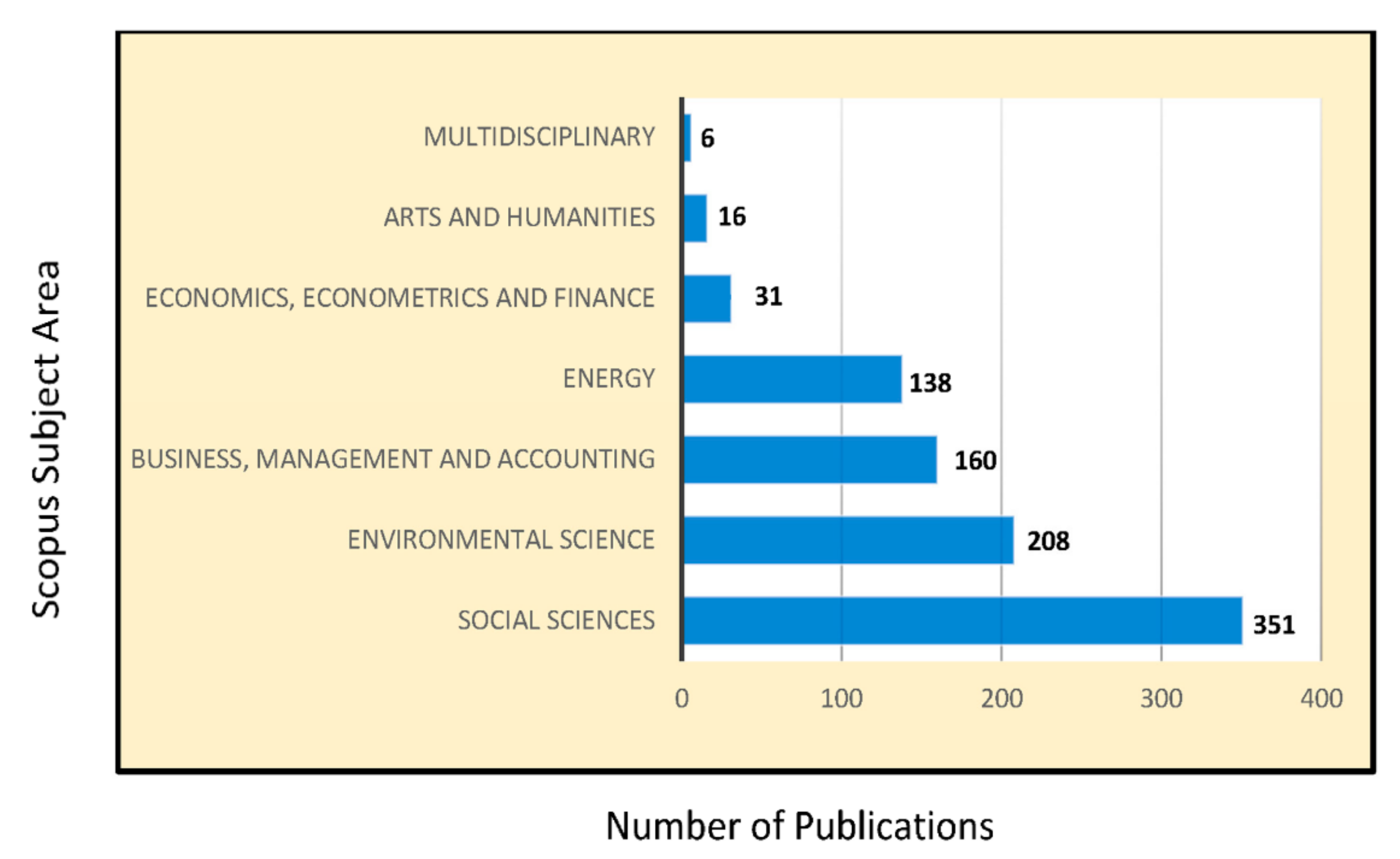
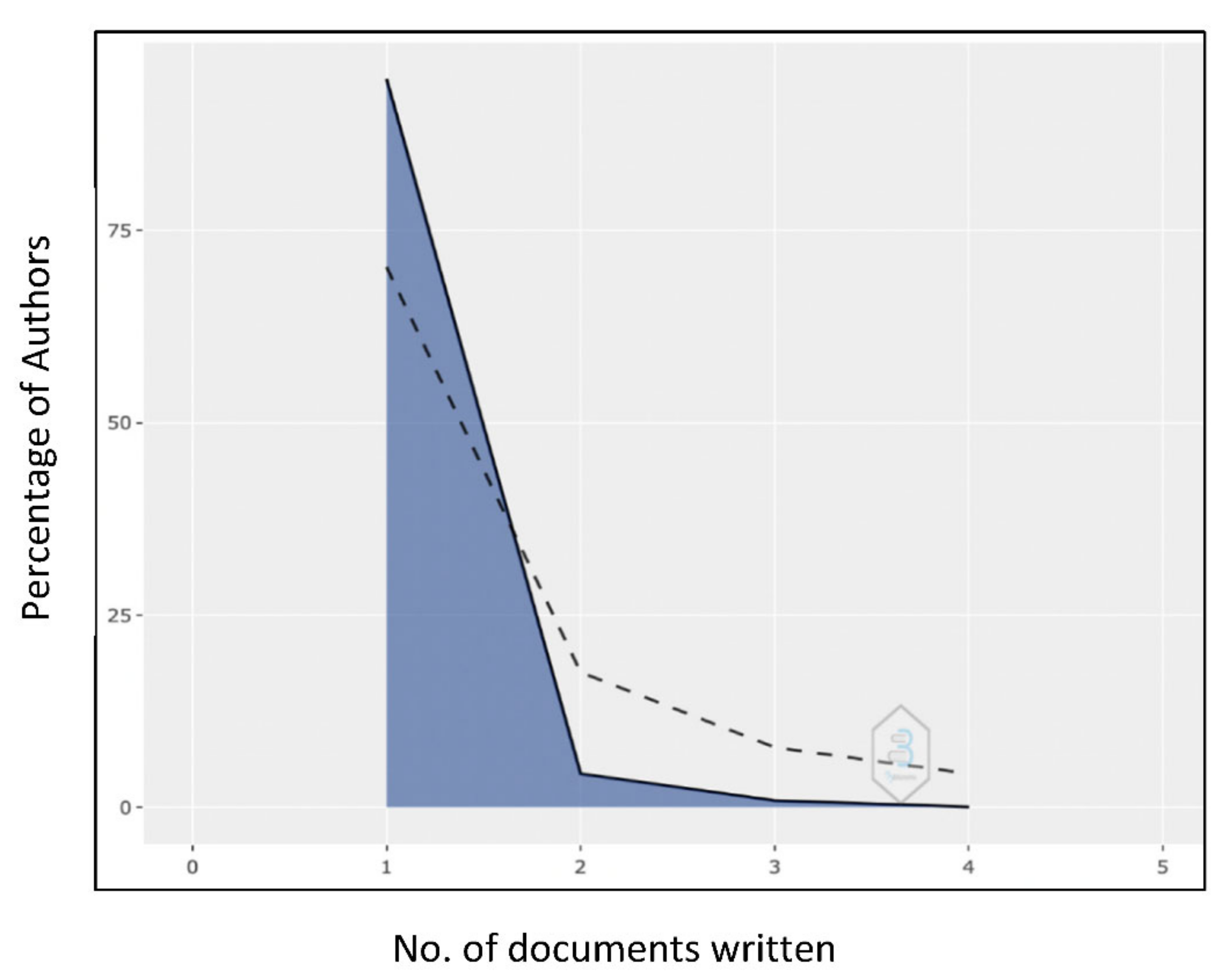

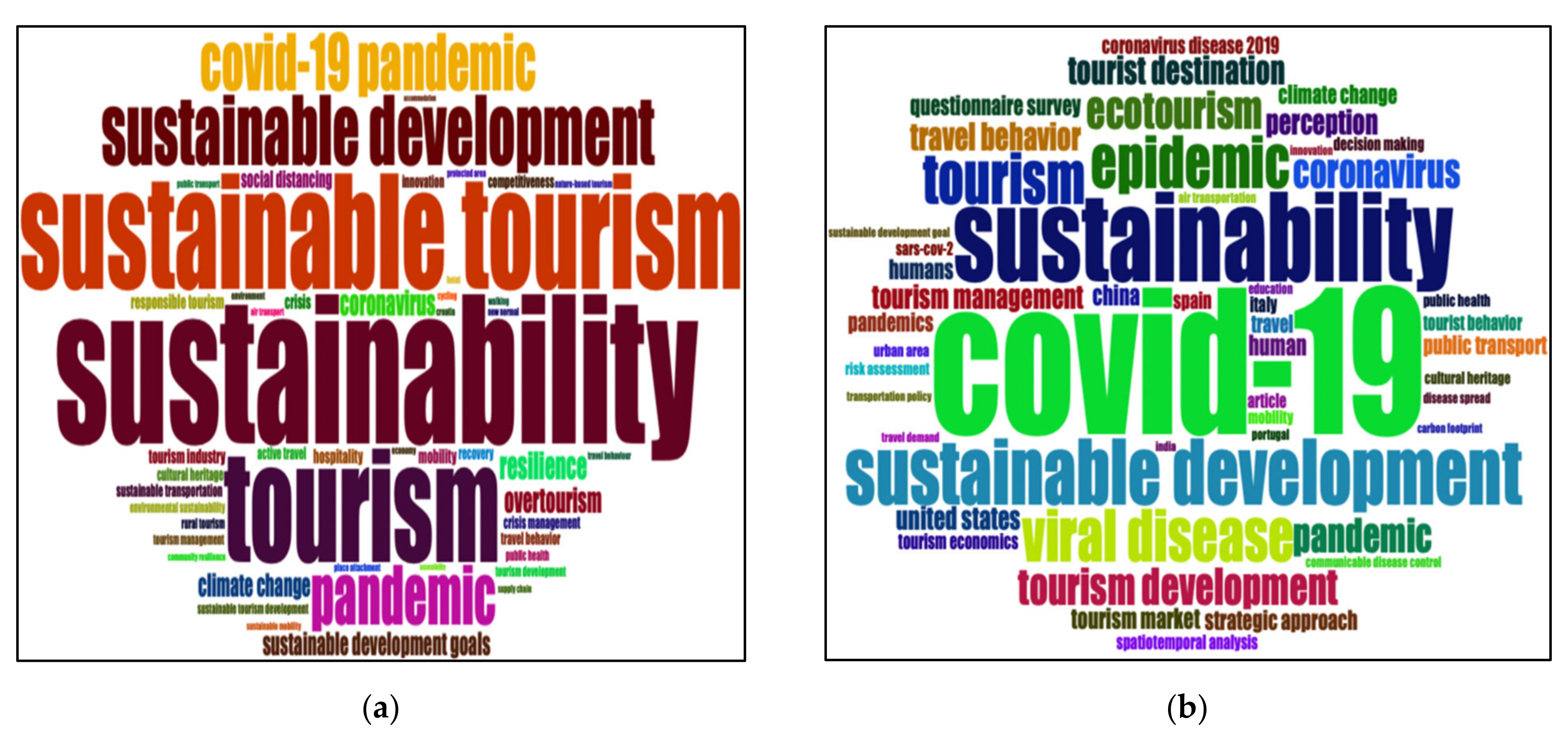
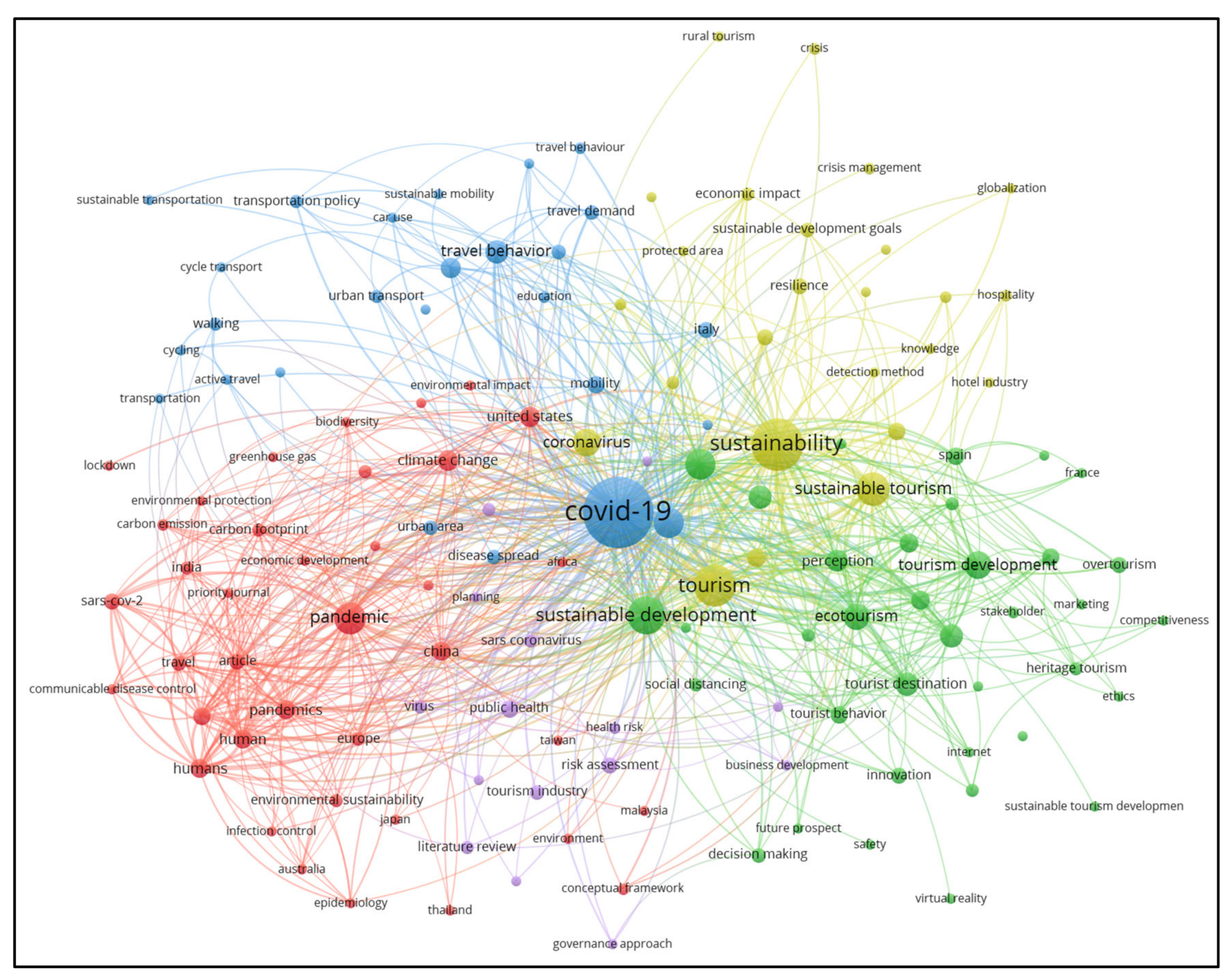
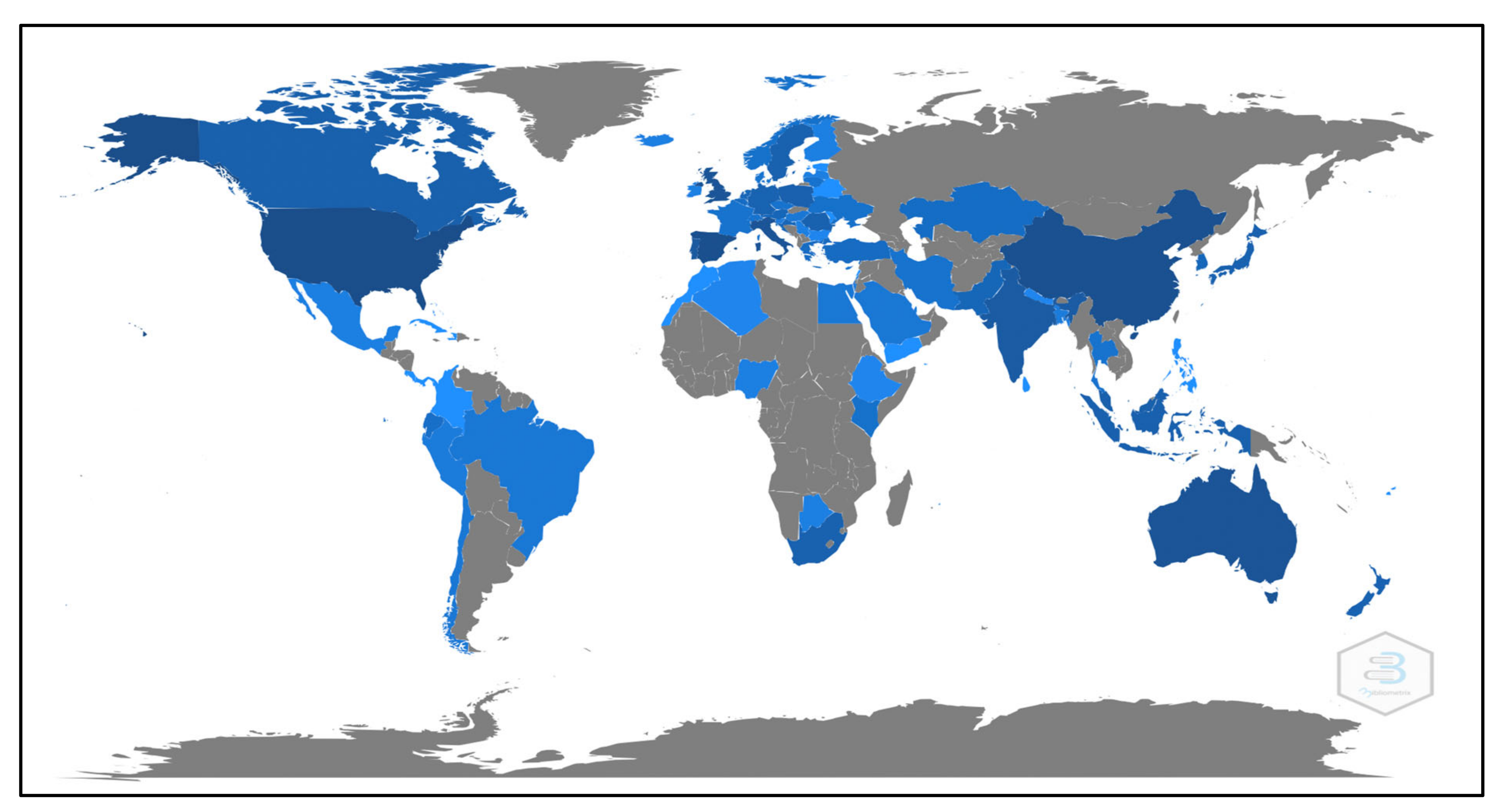
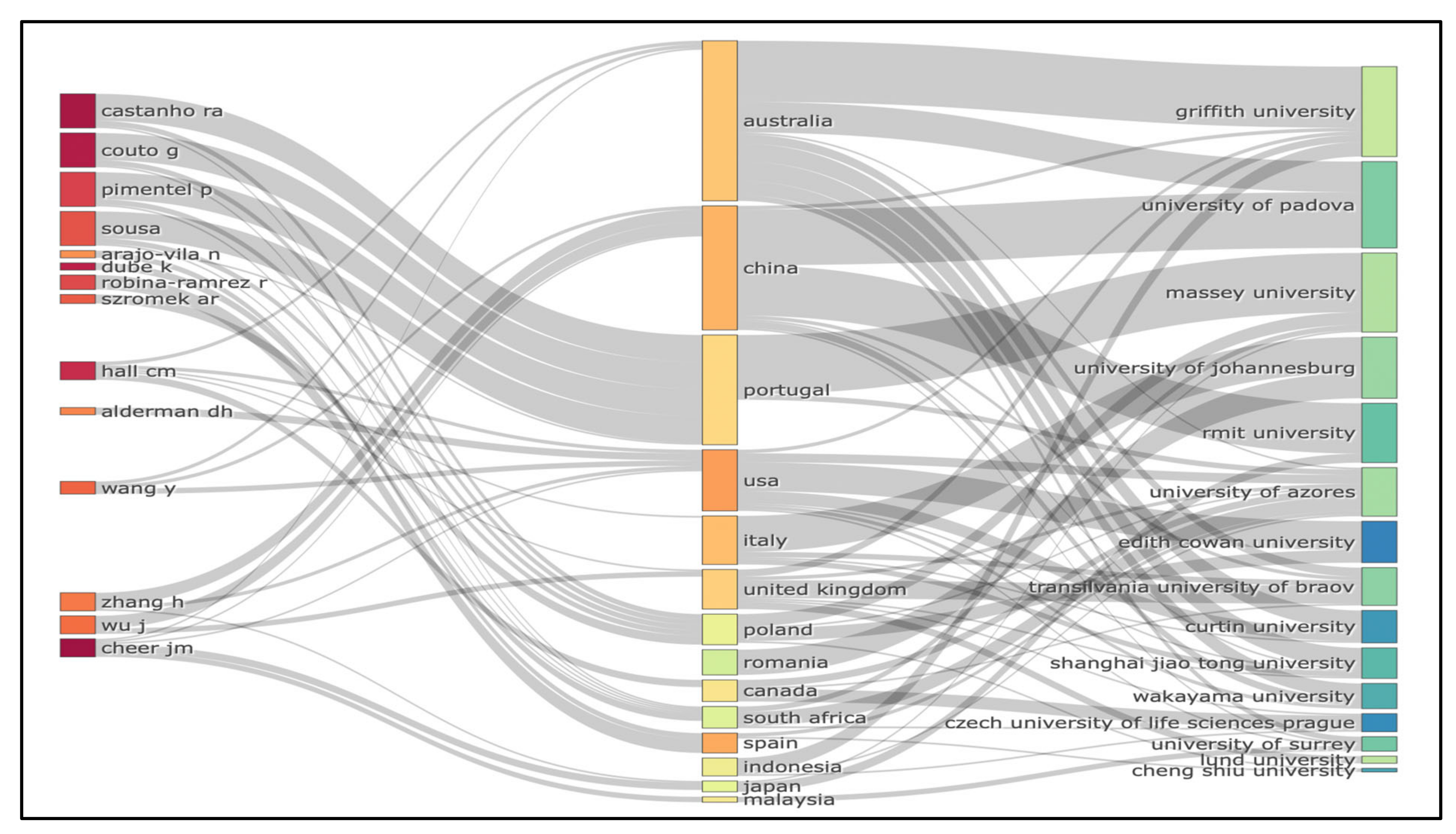
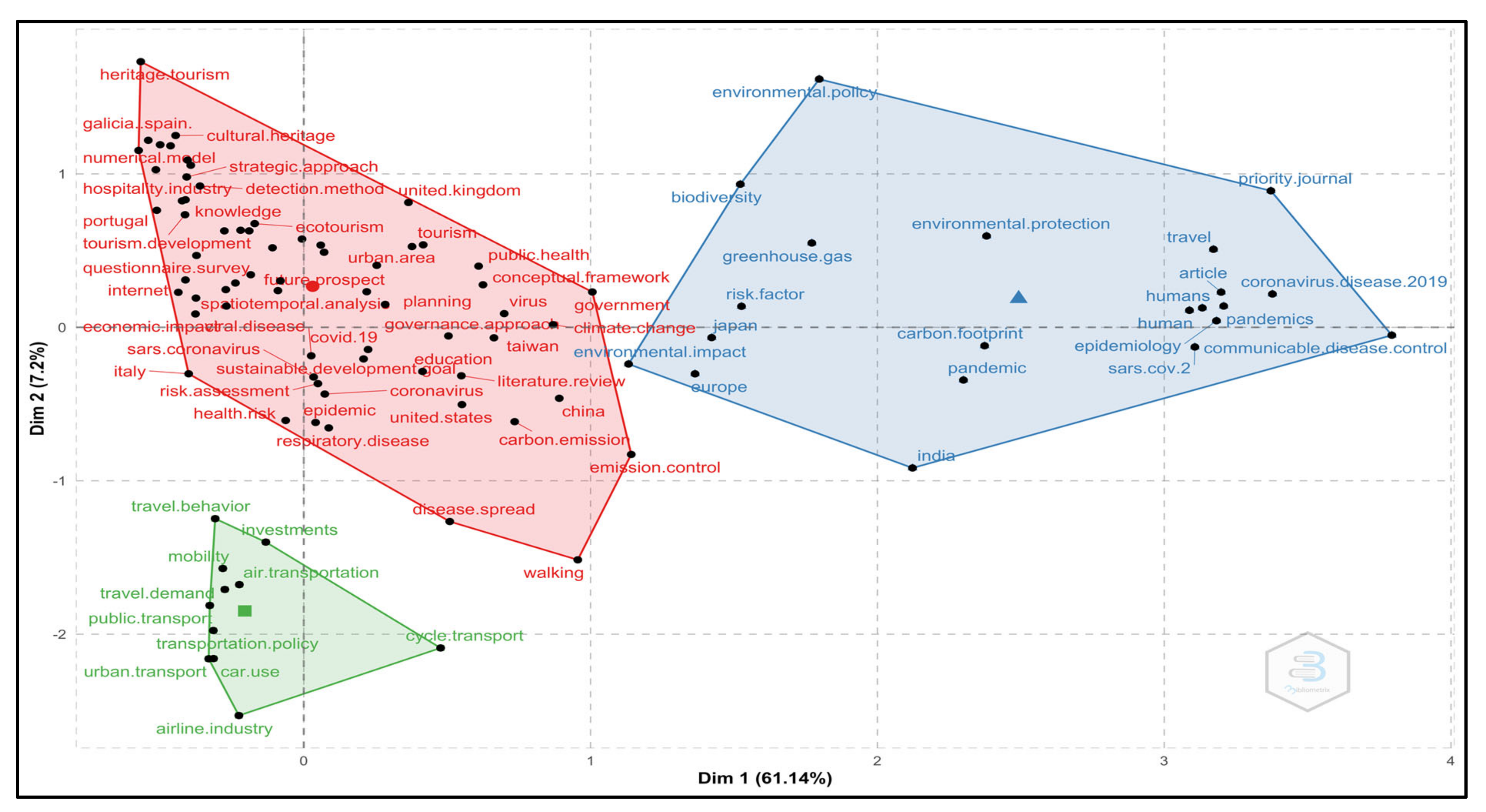
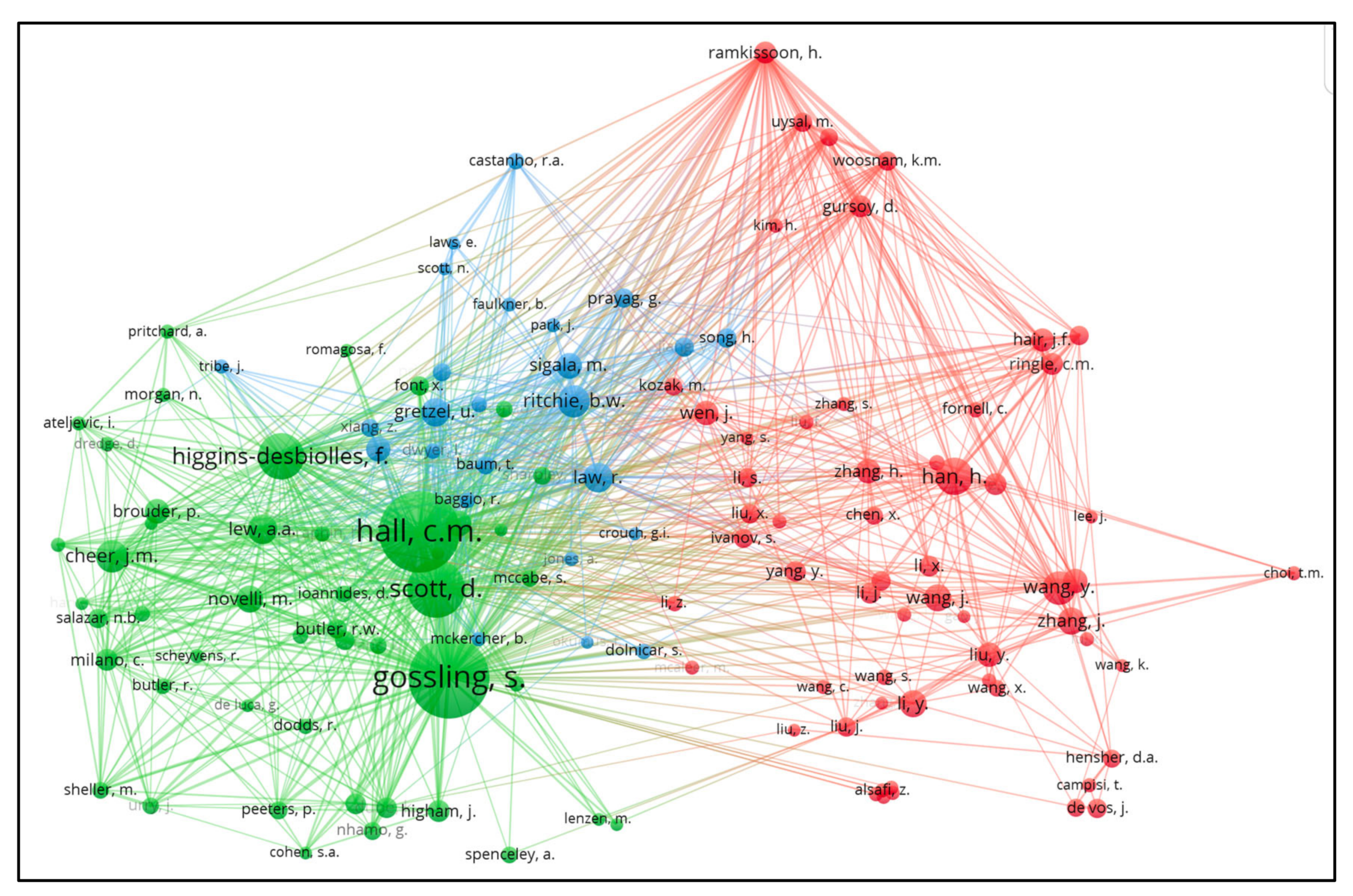
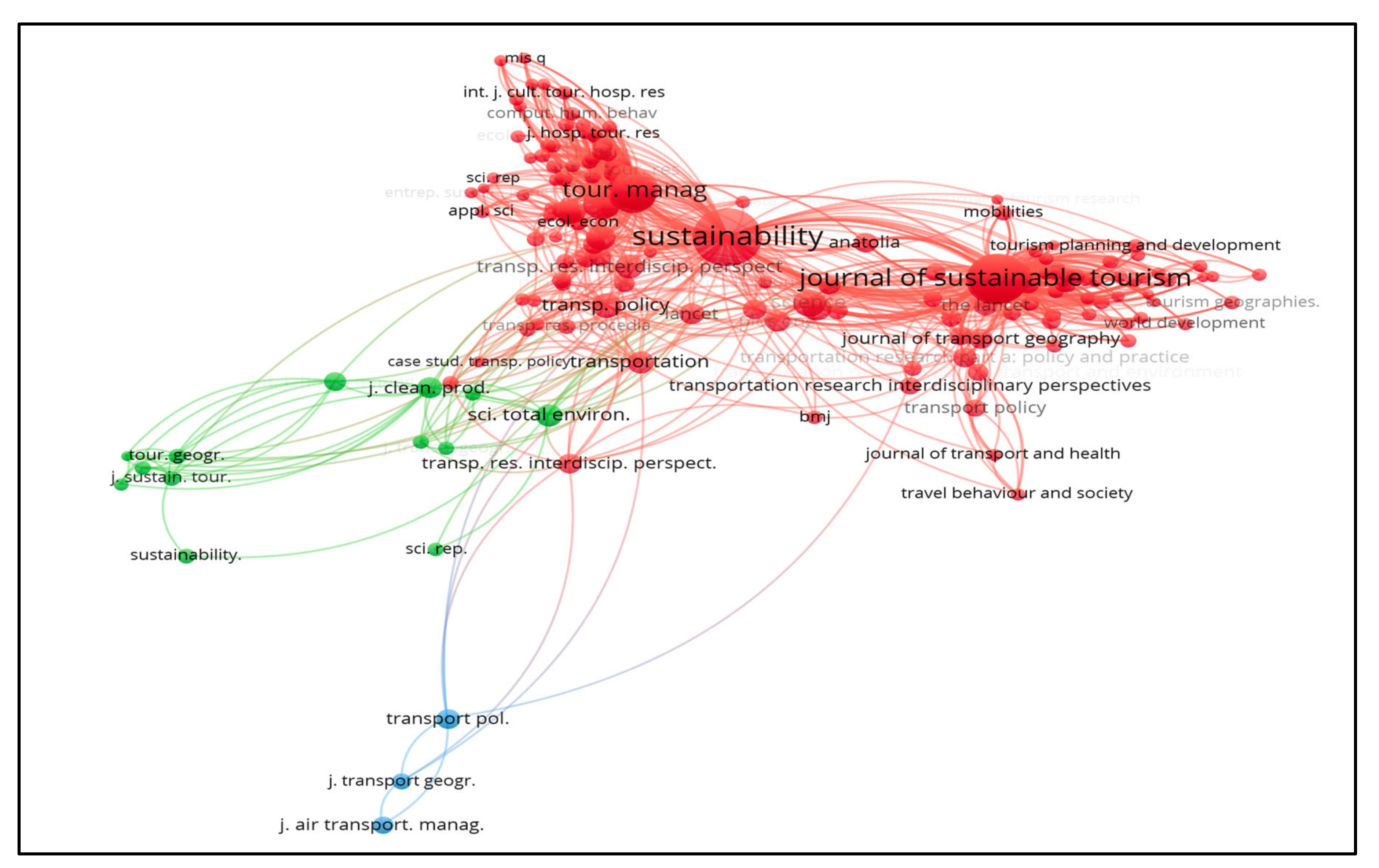
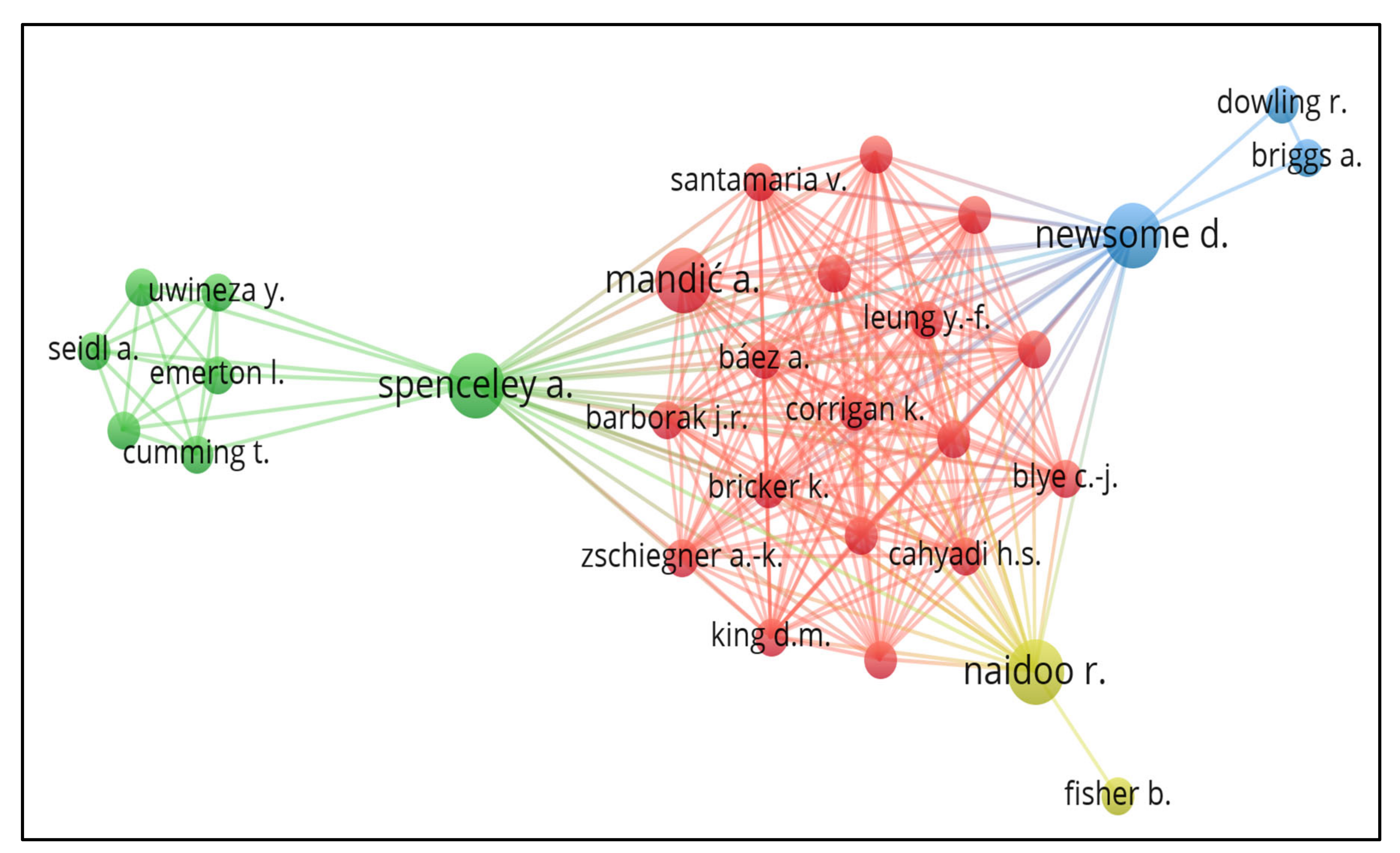

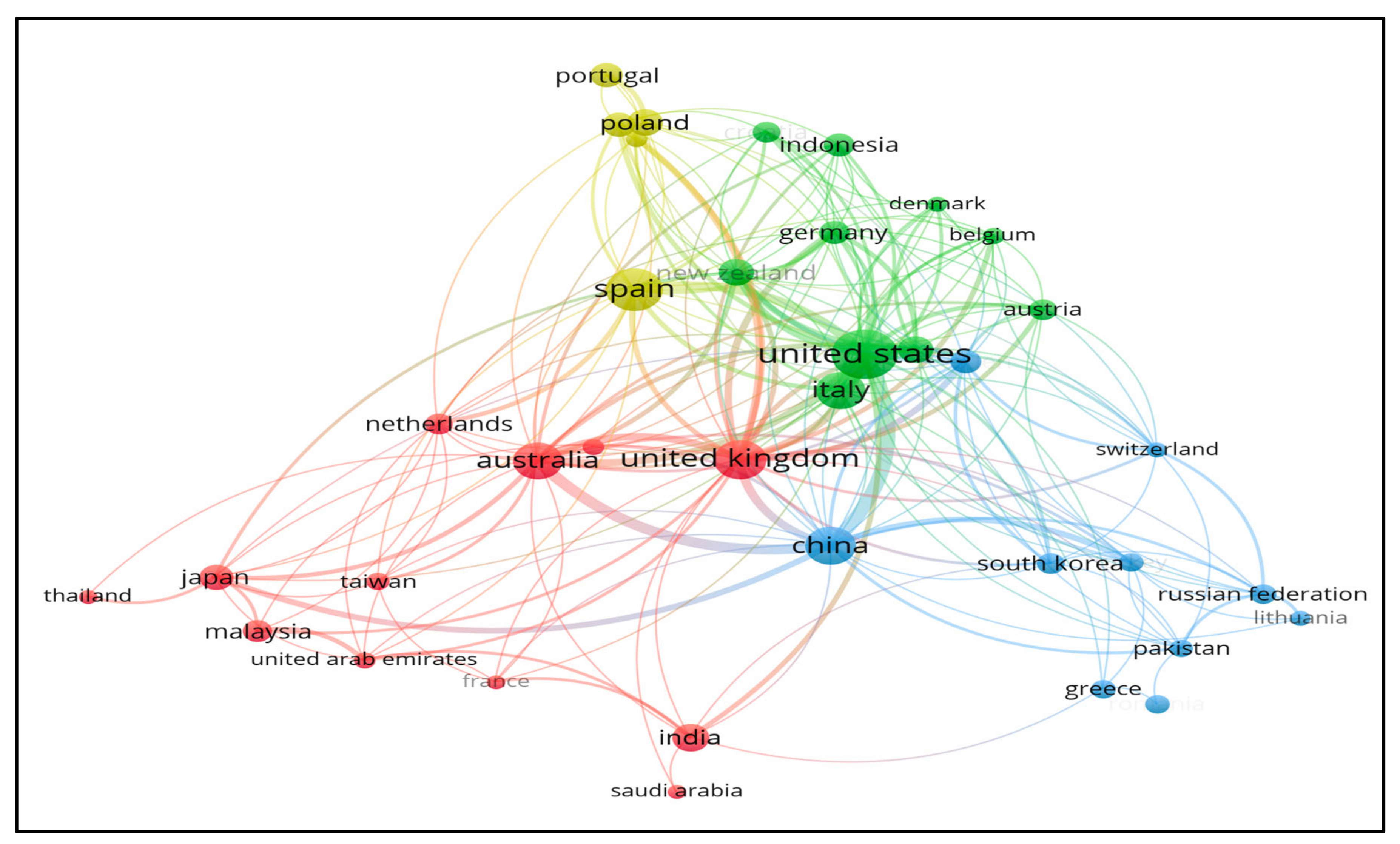
| Author | h-Index | g-Index | m-Index | TC | NP | PY Start |
|---|---|---|---|---|---|---|
| Hall, C.M. | 2 | 3 | 0.67 | 268 | 3 | 2020 |
| Gossling, S. | 1 | 1 | 0.33 | 235 | 1 | 2020 |
| Scott, D. | 1 | 1 | 0.33 | 235 | 1 | 2020 |
| Gyimthy, S. | 1 | 1 | 0.33 | 108 | 1 | 2020 |
| Ioannides, D. | 1 | 1 | 0.33 | 108 | 1 | 2020 |
| Choi, Tm. | 1 | 1 | 0.33 | 102 | 1 | 2020 |
| Naidoo, R | 2 | 2 | 0.67 | 95 | 2 | 2020 |
| Acquaye, A. | 1 | 1 | 0.5 | 91 | 1 | 2021 |
| Adamu, Z. | 1 | 1 | 0.5 | 91 | 1 | 2021 |
| Akintade, D.D. | 1 | 1 | 0.5 | 91 | 1 | 2021 |
| Source | h-Index | g-Index | m-Index | TC | NP | PY Start |
|---|---|---|---|---|---|---|
| Sustainability (Switzerland) | 12 | 20 | 3 | 583 | 77 | 2019 |
| Tourism Geographies | 12 | 15 | 4 | 769 | 15 | 2020 |
| Journal of Sustainable Tourism | 7 | 10 | 2.33 | 129 | 10 | 2020 |
| Transport Policy | 4 | 8 | 1.33 | 112 | 8 | 2020 |
| Transportation Research Interdisciplinary Perspectives | 4 | 4 | 1.33 | 92 | 4 | 2020 |
| Current Issues in Tourism | 3 | 8 | 1.5 | 69 | 9 | 2021 |
| European Transport Research Review | 3 | 3 | 1.5 | 20 | 3 | 2021 |
| International Journal of Environmental Research and Public Health | 3 | 4 | 1 | 27 | 4 | 2020 |
| International Journal of Hospitality Management | 3 | 3 | 1.5 | 45 | 3 | 2021 |
| Journal of Air Transport Management | 3 | 3 | 1 | 76 | 3 | 2020 |
| Science of the Total Environment | 3 | 4 | 1.5 | 58 | 4 | 2021 |
| Sustainable Cities and Society | 3 | 4 | 1.5 | 23 | 4 | 2021 |
| Worldwide Hospitality and Tourism Themes | 3 | 4 | 1 | 19 | 6 | 2020 |
| African Journal of Hospitality, Tourism and Leisure | 2 | 2 | 1 | 4 | 2 | 2021 |
| Energies | 2 | 2 | 0.67 | 14 | 2 | 2020 |
| Authors’ Keywords | Keywords Plus | ||||||
|---|---|---|---|---|---|---|---|
| Keyword | Rank (r) | Frequency (f) | Product (r*f) | Keyword | Rank (r) | Frequency (f) | Product (r*f) |
| COVID-19 | 1 | 179 | 179 | COVID-19 | 1 | 131 | 131 |
| Sustainability | 2 | 70 | 140 | Sustainability | 2 | 80 | 160 |
| Sustainable Tourism | 3 | 54 | 162 | Sustainable Development | 3 | 59 | 177 |
| Tourism | 4 | 53 | 212 | Epidemic | 4 | 47 | 188 |
| Sustainable Development | 5 | 33 | 165 | Viral Disease | 5 | 47 | 235 |
| Pandemic | 6 | 28 | 168 | Tourism | 6 | 46 | 276 |
| COVID-19 Pandemic | 7 | 27 | 189 | Ecotourism | 7 | 34 | 238 |
| Resilience | 8 | 13 | 104 | Tourism Development | 8 | 33 | 264 |
| Coronavirus | 9 | 12 | 108 | Coronavirus | 9 | 31 | 279 |
| Overtourism | 10 | 12 | 120 | Pandemic | 10 | 31 | 310 |
| Climate Change | 11 | 11 | 121 | Tourist Destination | 11 | 26 | 286 |
| Sustainable Development Goals | 12 | 11 | 132 | Travel Behavior | 12 | 25 | 300 |
| Social Distancing | 13 | 8 | 104 | Perception | 13 | 23 | 299 |
| Crisis | 14 | 7 | 98 | Tourism Management | 14 | 22 | 308 |
| Hospitality | 15 | 7 | 105 | United States | 15 | 21 | 315 |
| Title | Authors | Source | PY | TC |
|---|---|---|---|---|
| “Pandemics, transformations and tourism: be careful what you wish for” | C. Michael Hall, Daniel Scott, and Stefan Gössling | Tourism Geographies | 2020 | 235 |
| “The COVID-19 crisis as an opportunity for escaping the unsustainable global tourism path” | Dimitri Ioannides and Szilvia Gyimóthy | Tourism Geographies | 2020 | 108 |
| “Innovative ‘Bring-Service-Near-Your-Home’ operations under Corona-Virus (COVID-19/SARS-CoV-2) outbreak: Can logistics become the Messiah?” | Tsan-Ming Choi | Transportation Research Part E: Logistics and Transportation Review | 2020 | 102 |
| “A critical analysis of the impacts of COVID-19 on the global economy and ecosystems and opportunities for circular economy strategies” | T. Ibn-Mohammed, K.B. Mustapha, J. Godsell, Z. Adamu, K.A. Babatunde, D.D. Akintade, A. Acquaye, H. Fujii, M.M. Ndiaye, F.A. Yamoah, and S.C.L. Koh | Resources, Conservation and Recycling | 2021 | 91 |
| “Reset Sustainable Development Goals for a pandemic world” | Robin Naidoo and Brendan Fisher | Nature | 2020 | 82 |
| “How is COVID-19 reshaping activity-travel behavior? Evidence from a comprehensive survey in Chicago” | Ali Shamshiripour, Ehsan Rahimi, Ramin Shabanpour, and Abolfazl (Kouros) Mohammadian | Transportation Research Interdisciplinary Perspectives | 2020 | 75 |
| “COVID-19: from temporary de-globalisation to a re-discovery of tourism?” | Piotr Niewiadomski | Tourism Geographies | 2020 | 71 |
| “The COVID-19 crisis: Opportunities for sustainable and proximity tourism” | Francesc Romagosa | Tourism Geographies | 2020 | 69 |
| “Impact of COVID-19 on the travel and tourism industry” | Marinko Škare, Domingo Riberio Soriano, and Małgorzata Porada-Rochoń | Technological Forecasting and Social Change | 2021 | 68 |
| “Environmental effects of COVID-19 pandemic and potential strategies of sustainability” | Tanjena Rume and S.M. Didar-Ul Islam | Heliyon | 2020 | 65 |
| S. No. | Objective | Findings |
|---|---|---|
| 1 | Research trend | Excluding one article that was published in 2019, all were published in 2020 (n = 107) and 2021 (332), showing a growth rate of 210.28%. A total of 440 documents were produced by authors of 793 institutions in 81 countries. The 1351 authors of 440 documents reveal there are 0.33 documents per author and 3.07 authors per document. Of 440 documents, 71 were single authored, representing a collaboration index of 3.47. |
| 2 | Authors’ productivity | Cheer JM (4), Castanho RA (3), Couto G (3), Dube K (3), Hall CM (3), Peters M (3), Pimentel P (3), Ronina-Ramrez R (3), Sousa (3), Szromek AR (3), Wang Y (3), Wu J (3), and Zhang H (3). All other authors produced two or one document. |
| Institutions’ productivity | Griffith Univ. (11), Lund Univ. (7), Massey Univ. (7), Univ. of Azores (7), Univ. of Johannesburg (7), Univ. of Brasov (6), Univ. of Padova (6), and Univ. of Surrey (6). All other institutions produced five or less documents. | |
| Countries’ productivity | USA (105), Spain (92), China (82), Italy (63), Australia (62), UK (60), Portugal (44), India (37), Canada (26), Malaysia (26), and Indonesia (25). All other countries produced less than 25 documents. | |
| 3 | Dissemination of scientific production by sources | Sustainability (121), Journal of Sustainable Tourism (17), Tourism Geographies (16), Current Issues in Tourism (13), Transport Policy (12), and Worldwide Hospitality and Tourism Themes (10). All other journals produced less than 10 documents. |
| Sources dynamics | The only article in 2019 was published in the journal Sustainability. The most prolific journals in 2020 were Sustainability (33), Tourism Geographies (14), Journal of Sustainable Tourism (6), and Worldwide Hospitality and Tourism Themes (6). The sequence in 2021 was Sustainability (87), Current Issues in Tourism (13), Journal of Sustainable Tourism (11), and Transport Policy (11). | |
| 4 | Content of publications according to authors’ keywords | “COVID-19” (179), “Sustainability” (70), “Sustainable Tourism” (54), “Tourism” (53), and “Sustainable development” (33). Other important keywords include “Resilience” (13), “Overtourism” (12), “Climate Change” (12), and “SDGs” (11). |
| Content of publications according to keywords plus | “COVID-19” (131), “Sustainability” (80), “Sustainable Development” (59), “Epidemic” (47), and “Viral Disease” (47). Other important keywords plus include “Ecotourism” (34), “Tourism Development” (33), “Travel Behavior” (25), “Perception” (23), and “Tourism Management” (22). | |
| 5 | Top publications according to total citations | Hall et al., 2020 (DOI: 10.1080/14616688.2020.1759131); Ioannides and Gyimóthy, 2020 (DOI: 10.1080/14616688.2020.1763445); Ibn-Mohammed et al., 2021 (DOI: 10.1016/j.resconrec.2020.105169); Naidoo and Fisher, 2020 (DOI: 10.1038/d41586-020-01999-x); Shamshiripour et al., 2020 (DOI: 10.1016/j.trip.2020.100216) |
| 6 | Conceptual structure of knowledge | Cluster 1 includes keywords related to the management and sustainable development of tourism, such as “COVID-19”, “risk assessment”, “governance approach”, “strategic approach”, “emission control”, “SDGs”, etc. |
| Cluster 2 includes keywords related to environmental health, such as “envi. Protection”, “biodiversity”, “greenhouse gas”, “carbon footprints”, etc. | ||
| Cluster 3 includes keywords related to mobility trends, such as “cycle transport”, “car use”, “transportation policy”, “public transport”, “travel behavior”, etc. | ||
| Intellectual structure of knowledge | Cluster 1: Han, H.; Wang, Y.; and Li, Y., are the leading authors based on co-citations. Their documents were related to “travel trends amid COVID-19”. | |
| Cluster 2: Gossling, S., Hall, C.M., Scott, D., Higgins-Desbiolles, F, Cheer, J.M., and Higham, J. are among the most prolific authors. Their documents are related to “transformative opportunities for sustainability”. | ||
| Cluster 3: Sigala, M.; Dolnicar, S.; and Xiang, Z., are among the key authors. These documents are related to “COVID-19 impacts and tourism response” | ||
| Social structure of knowledge | Authors’ collaboration: 4 clusters of authors’ collaboration were resulted, and the most prolific authors per cluster are Mandić, A.; Newsome, D.; Naidoo, R.; and Spenceley, A. | |
| Institutions’ collaboration: A collaboration network of 20 organizations resulted based on the co-authorship of documents. Most of these organizations are located in the USA (5) and Canada (4). | ||
| Countries’ collaboration: Based on the co-authorship network, the strongest collaboration was observed among China, Australia, the UK, the US, and Japan. |
Publisher’s Note: MDPI stays neutral with regard to jurisdictional claims in published maps and institutional affiliations. |
© 2022 by the authors. Licensee MDPI, Basel, Switzerland. This article is an open access article distributed under the terms and conditions of the Creative Commons Attribution (CC BY) license (https://creativecommons.org/licenses/by/4.0/).
Share and Cite
Bhatt, K.; Seabra, C.; Kabia, S.K.; Ashutosh, K.; Gangotia, A. COVID Crisis and Tourism Sustainability: An Insightful Bibliometric Analysis. Sustainability 2022, 14, 12151. https://doi.org/10.3390/su141912151
Bhatt K, Seabra C, Kabia SK, Ashutosh K, Gangotia A. COVID Crisis and Tourism Sustainability: An Insightful Bibliometric Analysis. Sustainability. 2022; 14(19):12151. https://doi.org/10.3390/su141912151
Chicago/Turabian StyleBhatt, Ketan, Claudia Seabra, Sunil Kumar Kabia, Kumar Ashutosh, and Amit Gangotia. 2022. "COVID Crisis and Tourism Sustainability: An Insightful Bibliometric Analysis" Sustainability 14, no. 19: 12151. https://doi.org/10.3390/su141912151
APA StyleBhatt, K., Seabra, C., Kabia, S. K., Ashutosh, K., & Gangotia, A. (2022). COVID Crisis and Tourism Sustainability: An Insightful Bibliometric Analysis. Sustainability, 14(19), 12151. https://doi.org/10.3390/su141912151







